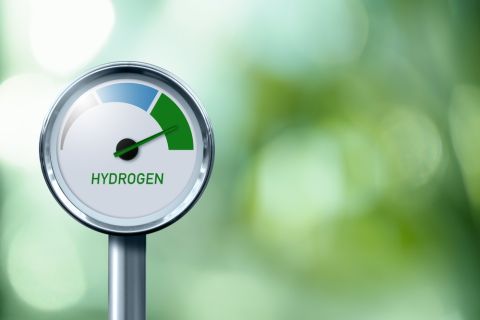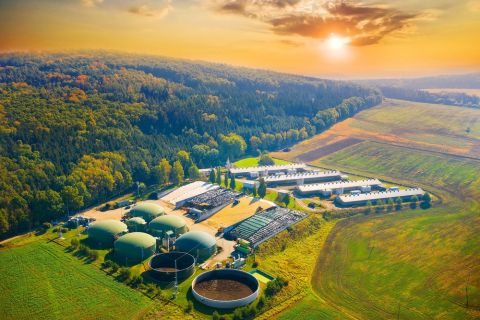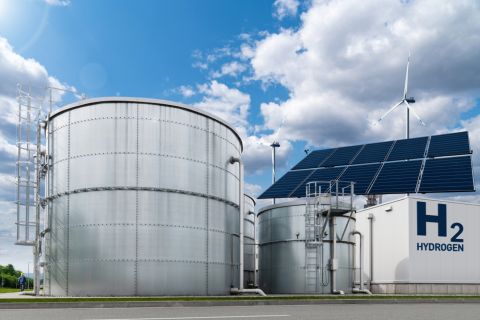One of the most popular New Year’s resolutions is to get into better shape by hitting the gym more. As any personal trainer will tell you, one of the biggest keys to improving fitness is strengthening the core muscles.
Similarly, when the natural oil and gas business cycle falls to the down side of the equation, it is important for both producers and operators to focus on their cores as well.
The Denver-Julesburg Basin’s (DJ Basin) Niobrara Shale has proven to be one of these core regions for the industry because it is one of the most resilient shale plays in North America in the midst of the current downturn. The play accounts for the bulk of the 22 drilling rigs active in Colorado and 13 rigs active in Wyoming, according to the most recent data available from Baker Hughes. The Niobrara produces crude oil, NGL and natural gas, though the primary focus of producers has been on the crude and liquids side.
Low well costs
Well costs remain lower than in much of the country with one of the largest producers in the region, Noble Energy Inc., stating it expects well costs to be below $3 million in 2016. Breakeven points have also been among the strongest in the country with Whiting reporting an average of $36.90 per barrel (bbl) in the Rockies.
Given the consistency of production out of the Niobrara, it is no wonder that the region is still one of the most active for midstream operators.
“The DJ Basin is one of the top two to three regions in the country. We’ve certainly seen a decrease in activity; but from a relative standpoint, it’s less of a decrease than we’ve seen in other regions,” Brian Frederick, president, asset operations at DCP Midstream LLC, told Midstream Business.
DCP Midstream is one of the largest midstream operators in the DJ Basin with nine natural gas processing plants that feature about 800 million cubic feet per day (MMcf/d) of capacity, as well as 3,500 miles of pipeline. These assets form an integrated system in the region to help to improve reliability, which is a strategy that has served the company well throughout the country.
Working together, these nine plants are optimized by improving efficiencies such as utilizing the facilities with the best recovery rates and least fuel usage first. “There’s an economic dispatch to all of the plants, including hydraulics. We can direct flows to a large extent, but depending on where producers are drilling and where the gas is coming in, pressures will also impact where gas flows,” he said.
Still growing
Frederick stated that the company has more than 85% utilization of these assets in the region.
Our philosophy is to grow with our producers by adding capacity as production grows. As producers see visibility and bring rates back that create growth, we are there to grow with them. We have a tremendous position in the DJ. It is one of our largest areas and is very high on our list of priorities,” he said.
In the past three-and-a-half years DCP Midstream has doubled its processing plant capacity as producers like Noble Energy, Anadarko Petroleum Corp. and PDC Energy Inc. ramped up activity in the play. Activity has regressed along with prices, but it hasn’t forced producers out of the area. Instead, the decrease in production has been rationed across the board.
DCP Midstream’s most recent project in the region was the $55 million, 25-mile Grand Parkway gathering expansion project. This 100% fee-based system went into service in early 2016 and lowered pipeline pressures in the region, which added incremental volumes from vertical wells that had been backed out by higher-pressure horizontal wells.
While the DJ Basin and the Niobrara, in particular, remain a key part of its growth strategy, Frederick noted that the company has deferred several projects that hadn’t yet been approved. However, these projects are scheduled to be built once price forecasts encourage producers to ramp up production.
More certain environment
Covering much of the Rocky Mountains, the region became active in the 1980s with horizontal drilling beginning in the 1990s. However, the play didn’t really begin to come into its own until 2008 when producers began to utilize drilling and fracking techniques learned from the development of plays like the Barnett and Haynesville. The most success has come from Weld, Yuma, Adams and Morgan counties, Colo., and Goshen, Platte, and Niobrara counties, Wyo.
Frederick stated that the area is a predictable one to work in from a midstream perspective with producers having fine-tuned their drilling and IP rates and an environment that is generally supportive of the industry. Bill Johnson, DCP Midstream’s vice president, north and Permian business unit operations, told Midstream Business that Colorado is highly regulated but knowing these well-defined rules and regulations makes for a more certain environment.
Though the play may be landlocked, it is accessible to export markets due to connectivity to the Mont Belvieu, Texas, hub through pipelines such as the 447-mile Front Range Pipeline that transports NGL to the Texas Express Pipeline. The Front Range Pipeline went into service in early 2014 and is one-third owned by DCP Midstream Partners, Anadarko and Enterprise Products Partners LP each. In addition, the pipeline is operated by Enterprise. Crude oil out of the Niobrara can make its way to Gulf Coast export terminals via the Cushing, Okla., hub.
In addition to DCP Midstream, other operators remain committed to the DJ Basin with Rose Rock Midstream LP stating during its third-quarter earnings call that it remains one of the most economic and efficient basins in the U.S.
Rose Rock grows
Rose Rock is also continuing to develop infrastructure related to the Niobrara as it recently expanded the Platteville, Colo., truck unloading facility by 10 bays. The facility, which includes 335,000 bbl of crude storage, is the origination point of the 526-mile White Cliffs Pipeline. This system traverses from the DJ Basin to Cushing.
The White Cliffs Pipeline, which is owned by a joint venture among Noble Energy, Plains All American Pipeline LP and Western Gas Partners LP, is also experiencing increased usage. Rose Rock, which operates the system, anticipated volumes to have increased from 127,000 bbl to 130,000 bbl in 2015. However, officials did caution that new pipelines could create some challenges for the system in the next several years.
“We expect there to be some variability in White Cliffs volumes due to the potential start-ups of competitive pipelines in late 2016 and early 2017. We continue to believe that these volumetric headwinds will ease over time as production grows,” Carlin Connor, CEO of SemGroup Corp., which owns Rose Rock Midstream LP’s GP, said during Rose Rock’s earnings call. He noted that last year, White Cliffs experienced decreased volumes when Tallgrass Energy LP’s northeast Colorado lateral pipeline was brought online and barrels that had been committed to the new system were redirected from White Cliffs.
“As a more competitive environment and the DJ materialize, we are very confident in our capital efficient system, which positions us for an effective tariff response if required and/or desired,” Connor said.
Strong economics
Tallgrass Energy also experienced growth in the region on its 760-mile Pony Express Pipeline, which runs from Guernsey, Wyo., to the Cushing hub. The system has a design capacity of 320,000 bbl/d of crude and will increase by 100,000 bbl/d later this year once its current expansion project is completed.
The pipeline experienced deferred revenue on 25,000 bbl/d in third-quarter 2015 as producers with take-or-pay contracts chose to pay rather than ship contracted volumes on the system due to the decrease in prices. These contracts are beneficial to both producers and operators, according to David Dehaemers, Tallgrass Energy’s president and CEO.
“It’s very understandable when you have producers getting $40 for their barrel of oil that they may not want to ship it to markets and instead want to keep it in the ground. They know they have the right to ship later on. That’s the great thing about Pony and its scalability,” Dehaemers said during the company’s third-quarter earnings call.
Because the DJ Basin is more mature than other shale plays in the western part of the country, such as the Bakken, it has more pipeline access. However, rail still plays a part in the Niobrara with ARB Midstream LLC’s Niobrara Connector (NiCon) Energy Hub being a prime example.
Rail opportunities
This crude-by-rail (CBR) terminal will be the third CBR terminal built in Weld County in the past few years and is being built on 225 acres in Evans, Colo., which is the closest any such terminal has been located to the heart of the Niobrara.
The trains will be moved by Union Pacific Railroad and the three rail loop terminals will be able to accommodate 120 full tank car unit trains as well as multiple grades of crude oil and feature initial storage capacity of 200,000 bbl, which will be expandable to more than 400,000 bbl. Rail-loading capacity will be 79,000 bbl/d, with initial truck unload capacity of 35,000 bbl/d when it begins operations in the first quarter.
Though current market conditions have shifted the company’s outlook for the project, it still anticipates demand for the facility moving forward especially to the West Coast. In a recent Genscape report, the company’s CEO, Adam Bedard, said that there are opportunities for CBR in the region. He highlighted light crude, which is constrained out of the region to the West Coast due to lack of pipeline capacity.
Bill Moler, Tallgrass Energy EVP and COO, stated that the various modes of crude oil transportation also work together in providing efficiencies in the play. “The beauty of crude oil is there are alternatives and options. It can move by truck, train, and pipeline. It can move by a number of different means and methodologies,” he said during the company’s third-quarter earnings call.
An example of this was the decision by multiple producers to defer shipping volumes out of the region as there was strong local refining demand as refiners in the DJ Basin could acquire locally produced crude at a lower cost than volumes out of Cushing. Many of these producers chose to pay deficiency payments for contracted volumes they didn’t ship on the pipeline. Both Tallgrass and Rose Rock noted that the Pony Express and White Hills pipelines were shipping at contracted volume levels in the fall and winter.
While 2016 is looking like a year of rebuilding, the strong production volumes and number of construction projects being developed in the Niobrara are certain to lead to improved health for the industry in the years to come.
A Producer’s Perspective
The Denver-Julesburg Basin continues to be a stronghold for Noble Energy Inc., one of the basin’s largest producers. Commodity price may have fallen in the past 18 months, but improvements in drilling efficiencies and completion techniques are delivering impressive results.
“Drilling performance continues to be exceptional,” Dave Stover, the company’s chairman and CEO, said during Noble Energy’s third-quarter 2015 earnings call. The company reported record sales volumes in the third quarter with 116,000 barrels per day (bbl/d) of oil equivalent.
Stover also attributed some of the gains to the startup of DCP Midstream Partners’ Lucerne 2 processing plant in June 2015. “Lower line pressures helped our legacy vertical production, which averaged 25,000 bbl/d of oil equivalent during the quarter. This is an increase of more than 5,000 bbl/d of oil equivalent above pre Lucerne 2 rates,” he said. Noble anticipates that DCP Midstream’s Grand Parkway project will further help the company improve efficiency as well as overall reliability in the play.
Noble also lowered its spud-to-rig release times on standard lateral wells to between five and six days. It also reported improvements by using slickwater completions in certain parts of the play, which resulted in improved production and lower well costs. The most success with this technique has been in the Wells Ranch and East Pony sections of the Niobrara. Slickwater completions have lowered the completion costs by $400,000 per well in these oily parts of the play.
“We’re constantly looking for ways to improve our completions [in the DJ Basin]. We don’t expect one optimal completion design to work across the entire field. It’s likely to be different depending on where we’re operating at any given time,” Gary Willingham, EVP, operations, said during the call.
Another top producer in the Niobrara, PDC Energy, has had similar results in the play since the downturn with improved efficiencies that have helped the company meet production guidance with fewer rigs. Part of this is attributed to picking up more efficient rigs dropped by their competitors.
These efficiencies have helped produce impressive figures out of the Chestnut 27 pad, which has 10 wells on it with five in the Niobrara. “We are excited about what we are seeing there. It’s a little early to conclude that everything is going to be great with it, but it looks very favorable,” Bart Brookman, president and CEO of PDC Energy, said at the recent Jefferies Energy Conference.
The efficiencies being created in the Niobrara are resulting in steady production out of the region even as rig counts decrease, which is creating a need for increased midstream assets.
Recommended Reading
Baker Hughes Makes Flare Emissions Breakthrough
2024-03-14 - Baker Hughes has developed a new application for flare.IQ, its emissions abatement technology.
Shell Taps Bloom Energy’s SOEC Technology for Clean Hydrogen Projects
2024-03-07 - Shell and Bloom Energy’s partnership will investigate decarbonization solutions with the goal of developing large-scale, solid oxide electrolyzer systems for use at Shell’s assets.
Chevron, Brightmark JV Opens RNG Facility in Arizona
2024-04-10 - Eloy RNG produces RNG using anaerobic digesters at the Caballero Dairy in Arizona, Brightmark said April 10.
Identified Need: Hydrogen Safety Standards in an Emerging Sector
2024-03-22 - Establishing fire protection measures remains critical for industry growth.
Kraft Heinz, Carlton Power Partner to Develop Green Hydrogen Plant
2024-02-05 - Located at Kraft Heinz’s Kitt Green manufacturing plant in Wigan, Greater Manchester, the proposed $50.1 million plant will have a 20-megawatt capacity.





